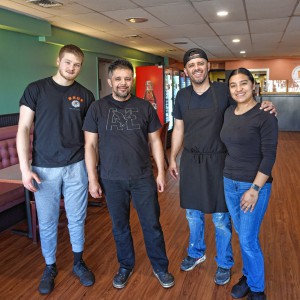Valley Bounty: The sweet science of a Leyden sugaring chef
| Published: 03-18-2023 11:47 AM |
Bob Bergeron, of Bergeron’s Sugar House in Leyden, has been sugaring for over 50 years. He first got hooked on maple during high school, at his grandparents’ sugarhouse in Whately, and learned through experience.
“While I try to make a few dollars, it’s about enjoying what I do. If you don’t like what you’re doing, it’s not worth doing,” Bergeron says.
Weather is a significant factor in how the maple sap flows, and the amount of sugar in the sap varies by year. “On average, the sap carries 2% sugar, which means it takes 45-46 gallons of sap to produce one gallon of syrup,” Bergeron explains. “It depends on the year and what the trees went through. You’re at the mercy of Mother Nature.
“Every year is different,” he notes. “A colder March is conducive to sap flow. We may have a good season yet.”
Bergeron uses home cooking as an analogy of the process. “All you’re doing is removing the water from the sap, the same as if you took sugar and mixed it with water on the stove, where eventually, it would turn into syrup,” he explains. “You have to watch the temperatures. It’s sugar and you can burn it. You have to be careful with everything.”
Bergeron’s equipment is a mixture of automatic and simple tools that work.
“We check everything with a hydrometer, to make sure the density of the syrup is correct,” he says. “The density has to be correct to be called maple syrup.”
All four grades of maple syrup have the same density, but the grade is determined by color. The color changes through the season, from lightest to darkest as the season continues. The intensity of flavor parallels the color, evolving from lightest flavor to strongest flavor.
Article continues after...
Yesterday's Most Read Articles
 Treehouse, Big Brothers Big Sisters turn race schedule snafu into positive
Treehouse, Big Brothers Big Sisters turn race schedule snafu into positive
 Northampton man will go to trial on first-degree murder charge after plea agreement talks break down
Northampton man will go to trial on first-degree murder charge after plea agreement talks break down
 Area property deed transfers, April 25
Area property deed transfers, April 25
 Contentious dispute ends as Hampshire Regional schools, union settle on contract
Contentious dispute ends as Hampshire Regional schools, union settle on contract
 South Hadley’s Lauren Marjanski signs National Letter of Intent to play soccer at Siena College
South Hadley’s Lauren Marjanski signs National Letter of Intent to play soccer at Siena College
 Primo Restaurant & Pizzeria in South Deerfield under new ownership
Primo Restaurant & Pizzeria in South Deerfield under new ownership
Bergeron explains that making maple syrup, maple cream and granulated maple sugar depends on the processes he uses to arrive at the desired consistency. Generally, “you heat it to the right temperature, then cool it down to the right temperature, and then it’s mixed,” he says.
Bergeron fuels his evaporator with wood. He uses reverse osmosis to conserve energy and remove water from the sap before the evaporator removes the rest of the water, leaving pure maple syrup. This process allows him to use just eight to 10 cords of wood for fuel for the season instead of the 40-50 cords that would otherwise be needed.
Swapping in more modern equipment is cost-prohibitive for Bergeron, he says: “I like boiling with wood and I’m going to keep going as long as I can.”
To make granulated maple sugar, Bergeron heats maple sap to 265 degrees and takes almost two hours. Next it is cooled and mixed, then sifted.
“It’s a lot of work, and everything is made with pure maple,” he explains. “To make a batch of granulated maple sugar is a long process that takes me five or six hours.”
Similarly, making maple cream requires careful attention to the details. “First I heat it to 232 to 234 degrees. Then the mixture has to be cooled down. I usually like to get it below 100 degrees and often let it sit overnight in a water bath with ice. Sometimes it gets so stiff, I can barely mix it,” he says. “I have to add a little bit of water to thaw it, and then I put it on the machine.
Timing is a factor in the final texture. “You want it smooth and creamy, so you can’t disturb it very much from the time you start to cool it to the time you mix it, because it can set up a crystallization process in the maple cream that is a bit gritty,” he says. “I might let it sit overnight covered, then put it on the machine. It can actually sit for a day or two as long as it’s cold. Then I portion it in containers and label them. It’s all very time-consuming.”
Bergeron built the sugarhouse as he prepared for retirement from a former career. He describes it as “a full-time job, year-round. It keeps me busy and keeps me healthy, too.”
The joy of maple sugaring, for Bergeron, “is that I’m able to keep doing it. It’s a lifestyle — not just a job or farming. Production season can be really intense. You only get one shot every year.”
Bergeron Sugar House sells maple products to local markets, including Maple Farm Foods, Big E’s, Atkins Farms Country Market, Atlas Farm, and Simple Gifts Farm.
Bergeron will offer a maple sugar tasting at a free event for kids and families called Making Food Fun, held outdoors at the Green Fields Market alley in downtown Greenfield on Saturday, March 25 from 10 a.m. till noon. This will be a chance for kids to learn about where maple syrup comes from and taste all four grades of syrup and maple cream.
“Maple syrup attracts kids because of the taste. The more they learn about it, the more likely they will use it as adults,” says Bergeron. There are vitamins and minerals in maple syrup, making it a healthier sugar many people favor. He adds, “During the pandemic, sales were steady because more people were home cooking.”
Making Food Fun is produced by Community Involved in Sustaining Agriculture (CISA) and the Franklin Community Co-op. Kids will get to choose their favorite maple product to put on silver dollar pancakes provided by the co-op.
Says Amy Britt, communications manager of the co-op: “Any way we can help kids and families connect with our local farms, taste fresh food, share where food comes from and meet the people behind the products is important. Local farms are the lifeblood of our food system, nourishing our families who live here.”
Family-friendly highlights include food sampling and demos, movement with the Franklin County YMCA, dairy fun with Our Family Farms, and parent information about school nutrition and food access programs.
Lisa Goodrich is communications coordinator for Community Involved in Sustaining Agriculture. To learn more about ther Making Food Fun event, see www.buylocalfood.org/events.

 Valley Bounty: Grass-fed animals that feed the grass: Gwydyr Farm in Southampton focuses on ‘restoring the connection between land, food and people’
Valley Bounty: Grass-fed animals that feed the grass: Gwydyr Farm in Southampton focuses on ‘restoring the connection between land, food and people’ Weekly Food Photo Contest: This week’s winner: Mary Chicoine of Easthampton
Weekly Food Photo Contest: This week’s winner: Mary Chicoine of Easthampton  Speaking of Nature: A romantic evening for two birders — To hear the wonderful sounds of the Saw-whet Owl one must go outside at night
Speaking of Nature: A romantic evening for two birders — To hear the wonderful sounds of the Saw-whet Owl one must go outside at night Speaking of Nature: Where have all the birds gone?: They’re there, and here’s a handy tool to keep track of their appearances
Speaking of Nature: Where have all the birds gone?: They’re there, and here’s a handy tool to keep track of their appearances
